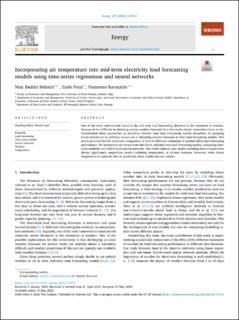Incorporating air temperature into mid-term electricity load forecasting models using time-series regressions and neural networks
Journal article, Peer reviewed
Published version
Permanent lenke
https://hdl.handle.net/11250/3127149Utgivelsesdato
2023Metadata
Vis full innførselSamlinger
Sammendrag
One of the most controversial issues in the mid-term load forecasting literature is the treatment of weather. Because of the difficulty in obtaining precise weather forecasts for a few weeks ahead, researchers have, so far, implemented three approaches: a) excluding weather from load forecasting models altogether, b) assuming future weather to be perfectly known and c) including weather forecasts in their load forecasting models. This article provides the first systematic comparison of how the different treatments of weather affect load forecasting performance. We incorporate air temperature into short- and mid-term load forecasting models, comparing time-series methods and feed-forward neural networks. Our results indicate that models including future temperature always significantly outperform models excluding temperature, at all-time horizons. However, when future temperature is replaced with its prediction, these results become weaker.

